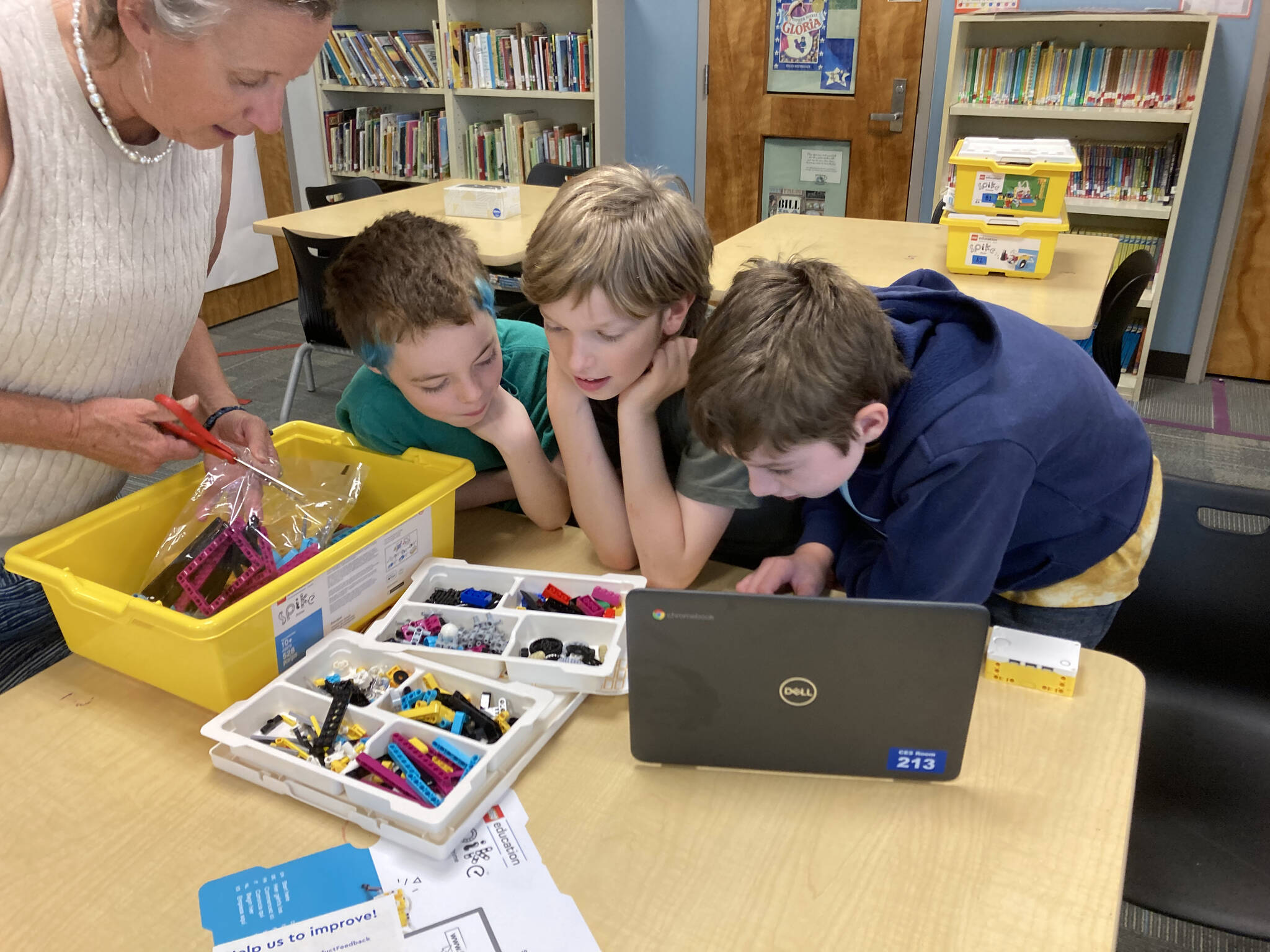Cheerful enthusiasm — this attitude reigned at the Chautauqua Elementary School (CES) Library in late August, as teacher-librarian Kathleen Lawrence led students in a practice run using a set of new robotics building-sets.
The Lego SPIKE Essential and SPIKE Prime kits will debut in the fifth grade this year, offering students a fun bricks-and-motors introduction to science, technology, engineering and mathematics concepts.
Former robotics students, and now sixth-graders Skyler McMillen-Meyers and Brooks Johnson, and fifth-grader Simon Tilden, helped Lawrence troubleshoot hardware and software, and built a small robot called “The Hopper.”
Lawrence began teaching the Robotics portion of the CES curriculum during the 2022-2023 school year, with the help of teachers and parent volunteers.
She doubted her skills in building robots initially. During that first year, she also saw students stymied and frustrated while working with much loved but exhausted materials and now-unsupported software.
She realized she didn’t lack the skills — instead, the robotics building sets that served the Vashon Island School District for 25 years had tipped into obsolescence. Grubby and exhausted, the materials seemed held together mostly with tape and good cheer.
Lawrence said she leaned heavily on volunteers and the CES Technology Department. Although they provided tireless help, she said, the program and its materials were breaking down without functional resources.
“The new boxes work better,” Lawrence said of the new kits. “[The previous kits] couldn’t download properly, and the electric cords were wonky and slow.”
Urgent plea and fast response
To keep the program viable, Lawrence scrambled to raise money for up-to-date materials.
She sent emails to parents and local businesses and fundraised on donorschoose.org. Former students, families and community members responded — one family delivered three new kits.
Additionally, she applied for funding from Vashon Partners in Education (PIE), an island nonprofit that puts money in the hands of educators.
Able to provide a rapid response within a month, PIE reviewed and funded the entire grant at over $13,000.
More than two decades ago, PIE provided the start-up money for the CES Robotics program as a grant submitted by former teacher Gail Labinski to enrich the fifth grade curriculum.
“The fifth grade robotics program is a perfect example of what PIE does — we put money directly in the hands of teachers to develop new programs that enhance the learning experience,” PIE board president Karen Boyle said. “The fifth-grade robotics program is definitely one of our most successful grants. Twenty-five years later, it is still up and running. We were thrilled to support this grant request.”
Lawrence said that PIE’s support “provided an escalator” when it came to fundraising.
Intuitive user experience
After logging on to a student-facing Lego app, McMillen-Meyers, Johnson, and Tilden dug into a box of an Education Spike Prime kit and built The Hopper, a robot that has to move forward without wheels.
The kits offer an array of creative opportunities.
While still using logic and problem-solving skills, the software uses visual blocks — color-coded grab icons that combine pieces of code. This simplified model makes coding available to a wider array of students.
The kit lesson plans increase in sophistication as students progress. They provide real-world problems for students to consider. This challenges kids to design and execute solutions to meet specific needs. And of course, these are Legos — so kids can build and program whatever they can dream up and fit together.
When asked about what he liked most about robotics, Brooks Johnson said: “It’s like a puzzle and you’re making the puzzle.”
Fifth-grade CES Robotics classes run three times per week for nine to 10 weeks.
At the end of the term, students demonstrate their robots’ functions in action for an audience of educators and parents. They describe their projects and present their findings. Then, they discuss the challenges they faced and how they solved them, taking questions from the audience.
Through the robotics program, students learn to work as a team. They choose projects and objectives collaboratively. They alternate between building and coding.
And they help each other learn. Last year, McMillen-Meyers and Johnson helped fellow students, they said.
“[Students] are asked to effectively and efficiently interact with peers, to give and receive help, and to share their growing expertise,” said CES fifth-grade teacher Nancy Jones. “It can be quite intense at times. Students can’t help but grow intellectually and socially, and they often naturally apply that personal growth to all sorts of classroom activities that have nothing to do with robotics but everything to do with collaboration and problem solving.”
Back to the future
The new robotics kits hone logic, troubleshooting, experimentation, group work and computational thinking skills.
Skills learned in robotics transfer to any field of study, helping students in whatever they pursue.
“Our program has instructed thousands of students over the past 25 years,” Lawrence said.
Currently offered only to the fifth grade, Lawrence aims to bring robotics to both higher and lower grades — starting perhaps with the third grade.
Former CES student Simon Derrer, commenting on donorschoose.org, wrote: “Robots at Chautauqua was a core memory for me and I think a not insignificant part of me becoming an engineer. I hope that this program continues and inspires so many more future engineers.”
With the participation of volunteers, donors and support from PIE, the Robotics curriculum can remain part of CES’ science curriculum.
“My dream … is to bring robotics to more grade levels and [build] district-wide collaboration and cohesion,” Lawrence said. “We are only just beginning!”
Marie Koltchak is the secretary of the Partners in Education board.


